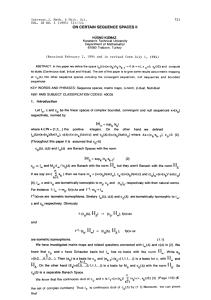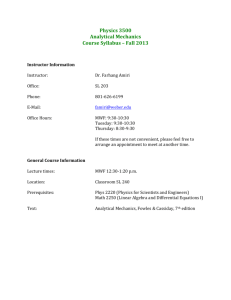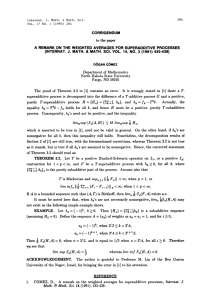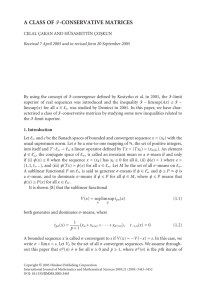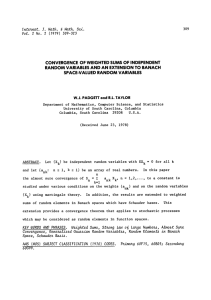Document 10443845
advertisement
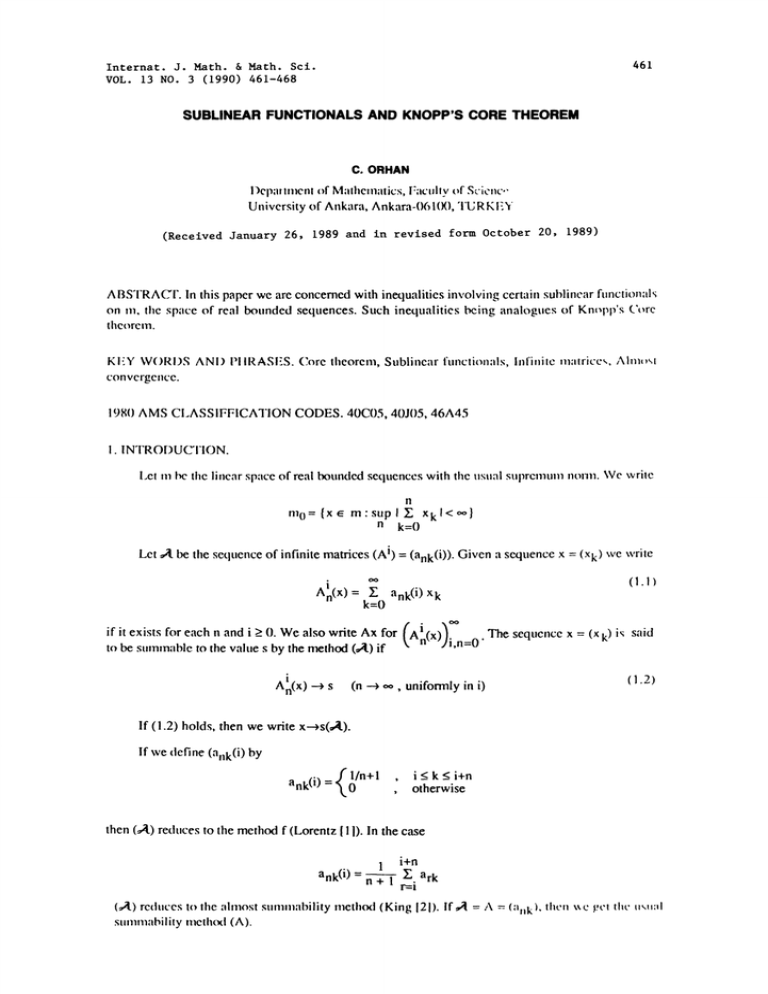
461
Internat. J. Math. & Math. Scl.
VOL. 13 NO. 3 (1990) 461-468
SUBLINEAR FUNCTIONALS AND KNOPP’S CORE THEOREM
C. ORHAN
l)ei’;utmcnt of Mathcrmtics, l:ac’.Ity of Scic.c,"
University of Ankara, Ankara-()61(10, "I’U R K F.’f
(Rece’ived January 26, 1989 and :l.n revised form October 20, 1989)
A BSTRA(YI’. In this paper we arc concerned with inequalities involving certain sublincar functionals
on m, the space of real bounded sequences. Such inequalities being analogues of Knopp’s (.’trc
theorem.
KI:.Y
Wf)RI)S ANI) iliRASFS. (;ore
theorem, Sublinear function:lls, inl’i,ilc ,,:trice,,,
con vergence.
1980 AMS Ci.,ASSIFFICATION CODES. 40C05, 40J()5, 46A45
!. INTRODUCTION.
l.cl m be tim linear space of real bounded sequences with the usu:i stq)rcmum nom. We write
n
m 0={xe m’suplE Xkl<Oo}
n k=0
Let 1. be the sequence of infinite matrices (A i) (ank(i)). Given a sequence x (x k) we write
Z ank(i) x k
A(x)= k=O
WealsowriteAxfor(Ain(X))oo
ifitcxistsforeachnandi>0.
to be summable m the value s by the method (1.) if
Atn(X)
s
(n
i,n=O"
,,*,
uniformly in i)
If (1.2) holds, then we write xs(,.).
If we define
(ank(i) by
ank(O
< k < i+n
otherwise
then (1) reduces to the mctiod f (Lorcntz 11). In the case
i+n
ank(i)
E. ark
r=l
(,.) re(lutes to the almost summability method (King 121). if
summability mcthxl (A).
Thesequcnccx=(xk) i’
said
(1.2)
C. ORHAN
462
and
The melhod (1.) is said to be :onservative l’x
s’, lhen () is called regular.
s’(). If )
implie x
i, c,n’,eraivc
It is well known, (Sticglitz 131), that () is regular if an(! only if the tllxing
hold:
X
k
ank(i)1<
(fi,r all n, for all i).
and there exist an integer m such that
sup
0,
lira ank(i)
n
lira T.
n k
uniformly in i,
I.’1
unifinnly in i.
ank(i)
(1
"i’hrough(,t tile paper we write
I11 sup
n,!
to mean that, there exists a constant
k ank(i) <
M such that
Z]k a,lk(i)
<M
I.,
(for all n, for all i)
and tile series
(!.())
E ank(i)
k
convreges unifonrfly in for each n.
If, for every bounded sequence x, x---s(l.) then (,,,’1.) is said to be a Schur
Throughout the paper we consider only real matrices and real tmndcd scqucncc,.
.
In this paper we arc concerned with inequalities involving certain sublinear fnctimal,; m
the space of real bounded sequences. Such inequalities being analogues of Knopp’s (’ore hcretn
Th:t theorem determines a class of regular matrices for which
limsup Ax < limsup x
for all x e m, see e.g Cooke I41, Maddox 151, Simons 161. This result has also been cxtcntlcd
corcgular matrices by Rhoades 171, Schaefer 181, and, Das 191.
Before stating tile theorems to be proved, we introduce some flrther notalion.
[(x) liminfx n L(x) limsupx n Ilxll
i+n
[.*(x)
limninf n
L*(x)
limsup su.p
su.p +
n
W*(x)= i:f L*(x +z)
z m0
E xr
r=i
i+n
xr
r=i
:
sup
Ixnl
KNOPP’S CORE THEOREM
SUBLINEAR FUNCTIONALS AND
463
If f, g arc any two of the atx)ve functionals, we shall write fA <_ gB to denote that, for
I))tll(lctl .,,tlUClt’ x, tle tran.,l’orms Ax and Bx are defined an(I boltndcl aml f(Ax) < g(llx).
every
2. ’1’1 I1" rl,,\lN RI!.’qUI.’I’S.
Wt"
,,.
itc, It x
ti Ill,
QA(x)
limsupn st’tl>
ank(i) xk
qA(x)
liminfn st!p
ank(i) x k
dil(l
\Vltt ttlt.,, totation we have
"1"! ll..’()RI:.M.I. Let I11.11 < ,:,o. Then
QA <L
1 aid ,ly if (,,A.) is
regular and
T[k a,,k(i)
I’R()()i:.
2. ), wc
(2.1)
-
(n--), tmifomly i,, i)
(2.2)
(x k) be a c()nvcrgcnt .,,etltcnce. "rhcn [(x) --l.(x)= libel x. l}y
Necessity. l.ct x
Iavc
[,(x) < QA(-X) < QA(X) < L(x).
Icltc we get that
lira x. So (,A.) is regular.
QA(X) tlA(X
.
.’,;i,cc (..A.) is regular, the requirement of i..emma
e\i.,,t.,, y e
such that Ilyll < and
linsui) sup 1 ank{i)
QA(Y)
lic,i.c, taktlg x
c
(1,1
2, (Das 191), is satisfied, ltence there
), we lmve
--qA(C)*_" litninf SUl) T.I a,k(i)
kl
< limsup sup ank(i)
k’Xl
n
w, llci i)r)vc.,,
;iiltl A
QA(Y) < L(y)< iiyil <
the necessity of (2.2)
.";tllticicwy. Wc dcl’inc, for ;ilay real Z.,
)L
L’. lcncc
*
max
(X,()), X."
T_.,a,k(i) xk= E ank(i) x k+ E ank0)
k
k<m
k>m
Y’.a,,k(i) x k <llxll Z hnk(i)l+ (sup Xk)
k
I-
k<m
k>_m
x k-
i.ax
(-*,1)). "l’il. I;kl
E a’lk0)
k>m
k>_m
By hypothesis, we get that QA(X) < L(x).
REMARK. We could use Theorem 2, (Das 191), to get the sufficie,cy.
xk
:k +
-
*
C. ORHAN
464
Cf)R()IJ,AR Y.2.
We have on m,
[ < I,* < 1,* < i,.
PR()()F. in Iheorem
1. il is enough to lake
_< k _<. i-n
otherwise
l/n+
0
ank(i)
We de(lute at once from Corollary 2 that if a sequence x is convergenl to s. tllelv it is altvu)’,t
convergent to s which is a well-known result.
We note that,
,*A_< !, and I.A .<_
by considering l’heoren) l, one may get necc,,ary anti
,, fficicnt
(’
m(liti,r, I,,v
in the next Iheoren) we consider the inequality I.A < 1.*.
-
TI IEOREM.3. LA _< I,* if and only if A is strongly regular and
E bnk
k
(n -+ ,:,,,)
(2 )
PROOF. Recall that a matrix A is called strongly regular if it maps all
se(luences into the convergent sequences and lira Ax f- lira x.
.
We first prove the necessity, it is easy to see that [.* <[,A < I.A < !. If x i, alvu,,,t c(,ivergev!
[.*(x) L*(x). tlence, by the hypothesis, [.(Ax) L(Ax) f- lira x. So A .,
strongly regular. Using the fact that L* < I, (see Corollary 2) and that LA < I.,*, we get float IA 5 I..
Now tile necessity of (2.3) follows from Knopp’s Core theorem (see, e.g. IVlatldox 151).
then f- lira x
We note in passing thal a matrix A is strongly regular, Lorcntz [l ]. if an(l (rely if i
i,
vcgtlar
and that
Y: hnk- an,k+ll --> 0
k
(2.1)
(n -+ oo)
Sufficiency. Given : > 0, we can find a positive integer p such that for x
k>O,
k+p
xr < L*(x) +
+
P
r
m anl for all
(2.5)
E=k
(We fix p throughout the analysis).
As in l.x)rentz’s proof (see 111; Th. 7) one can show that
Z ankx k=
k=O
v
E
E ankxk
k =0
+
-
nk +"" +
k=p
p-I
+
k+kP
kO ank --4:Tr=
"
xr
an,k-p
an
P-11ank an,k_p+l)
E
k :-0
+
+
+
xk
(2.6)
_
SUBLINEAR FUNCTIONALS AND KNOPP’S CORE THEOREH
465
Since x e m, it follows from the regularity of A that the third and fourth sigmas in (2.6) tend
:,. n -)
If we write
t) zc,t)
,.
l:np=" k
p
(_n_k.
+
+ an,k-l
p+
k)
"an Xk
] hnk+...+an,k_p-(p+l)a,,kllXkl
[F,,pl<-+--]- k=p
_< I1___11___
p+
Z
.
r=O k=p
"lan,k_ r- ank
E r Z "lank- an,k+l
<p.-i r=O
k=()
P
y’.
<
-b Ilxll
k =(1
ktnk-a,,k+!
(2.7)
Siucc A is strongly regular, (2.4) holds. Thus the expression in (2.7) tends to zero as n---,,,,.
11cncc we t’iml that
,
lly (2.5), wc have
I.(Ax) _< (l.*(x)
c)limsup
ttkl + Ilxli iimsul,t
(k,tkl-auk)
tim regularity of A and (2.3) we get that
L(Ax) < L*(x) + e.
Stut.’c t" in arbitrary, sufficiency follows.
’i’111:.()REM.4.
I..*A < 1.* if and only if A is F-regular and
i+n
limsupZ
n
k
n---g-yEr--I arkl=l
I’ROOF. Recall that A is called F-regular if it maps F, the class of all almost converge,t
.SCtlUenCes, imo itself and f-lira Ax f-lim x. Corollary to Theorem 4 in IOI gives the necessary a,d
.sufficient conditions for A to be F-regular.
We now come to the proof of necessity.
can easily show that
C. ORIIAN
66
f,*(x) _< ,*(Ax) _< L(Ax) _< L*(x).
Ifxe I:, lhcn [,*(x)
f- lira x. llcncc l,*(Ax)
L*(x)
f- lira x. So A is
L*(Ax)
i’ regular.
"!’ gc the necessity of (2.8), we define (bnk(i)) by
bnk(i)
()bscvc nw flint lhc conditions of
I),lcd ClUCWC y such that Ilyll
and
_
ig[
Z. ark
:1
Lcmma 2,
l)as
191, arc satisfied. So wc mus have a
(2.9)
QB(y) iimsup sup Z Ibnk(i)l
n
k
lcncc by (2.9) and F-regularity of A, we get
iiminf sup
n
.
k
i__i_
iimsup sup
n+
n
.
i+n
_---vn..arkl
i+n
ark
i+n
limsap sp
( ri ark
il
Yk N l.*(y) N ly N
Sullicicncy. Wc f]rst note that
i+n
l.*(Ax)
limsup sup -+-[n
r=i
At(x)
i+n
n+-I E.ark )xk
limsup sup
(---
n
we set
i+n
E.ark
bnk(i)
r=l
to "i’hcorem
then (2.6) with ank relaced by bnk(i) holds. Since xe rn and A is F-regular, Corollary
to zero as n--oo,
tend
by
replaced
with
bnk(i),
third
sigmas
and
in lOi yields that the second
ank
than
uniformly in i. On the other hand IFnpl, with ank replaced by bnk(i) is not greater
i+n
P-2
Ilxll
k
Ibnk0)-" bn,k+ l(i)l
-P k I--l--n i (ark- ar’k+
Ilxll
+
)1
we have, hy 2.5).
Since A is F-regular, the last sigma tends to zero as n.-oo, uniformly in i. lcncc
that
( k) fX
i+n
L*(Ax) < iimsup sup
n
k
n/-|
r=i ar
k+
+x k+
p)
SUBLINEAR FUNCTIONALS AND KNOPP’S CORE THEOREM
< (L*(x) + c) limsup sup
n
+ Ilxll
Z n+
k
467
Z. ark
+ I i arkl" --]- r=E" ark)
limsUPn st.pt k (I-!-n
Using (2.8) and the fact that A i,; F-regular, we get
L*(Ax) < L*(x) + r.
Since e is arbitrary, the required conclusion follows.
We now give another ingcquality shaqer than that of’i’heorcm 4. (See "i’hc,,en 6 I,clx
also an analogue of Theorem 3 given by Devi !1. We first need to prove a l.cnma.
LEMMA.5. Let (B (i)) be a sequence of infinite matrices such thnt (1.3) and (1.5), wih
replaced by bnk(i), hold. "i’hcn, for every z m0, we have B z 13 y whcrc
13
).
It
i,
a,kli
(dnk(i)) (bnk(i) bn,k+lfi)),
and
If, flrther
li,n
E Idnk(i)l O,
uniformly in i,
n k
then y
--)
O(I)) and z
O(B).
PROOF. The first assertion follows from Abel’s partial summation. The
consctlucnce of the Result (3.2. I) given by Duran I0l.
We arc now in a position to give the i.eqmlity mentioned above.
TItEOREM.6. L*A < W* if and only if A is F-regular and (2.8) holds.
Before proving the theorem we note that W* is well-defined (see Devi il !1).
We now come to the proof.
Suppose that i.*A < W*. Since W* < L*, it follows from Theorem 4 that A
is F-rcgla
that (2.8) holds.
Conversely stnpposc that A is Ercgular n(! (2.8) hohls. Ily "i’hcc)rc0l 4, we get
u(x)
inf l.*(A(x+z)) _<_ W*fx)
(2.1())
Z Ill 0
On the other han(I
i+n
L*(A(x+z)) limsup sup -].-[ F. ark (’(k + Zk)
n
k
r---i
Now write
.
i4n
bnk(i) i--]- ark
r.=l
(2.!}
C. ORHAN
468
Since A is F-regular, the requirement of I,cmma 5 is satisfied. Icncc wc hac tl: z-, )(B S.
get
u(x) i,lf
7 m0
<l,’(Ax)+t*(Az)= i.*(Ax)
(2
t’
I’I
lcncc the required conclusitm follows from (2. !(I) and (2. I).
The following theorem is a generalization of Result Vil given by Kuttncr and M:dhx I121.
TItEOREM.7. Let I1,,1.11 <
metht’xl and
and
II:B II < ,,,,. Then QA(x) < qll(X)
E bnk(i) bnk(i)l-- 0
k
(n
-
if only if (13) is a Sclur
oo, tmifonrdy in i)
PROOF. Since the proof uses the technique that Kuttncr and M,’ddox u.,,ed,
2 I. wc mit the
details.
We conclude the paper with the following remark: Since no Schur mcthd is rcglr. l’hc,ct
7 includes the result that QA(X) < qB(x) is impossible when (I],) is a regular method. For example,
QA(x) _< [(x)
(for every x m),
is impossible.
REFERENCES
Lorentz, G.G. A contribution
to the theory of divergent
sequences. Acta Math. 8__]) (194g),
167-190.
2.
King, J.P. Almost Summable sequences. Proc. Amer, Math. Soc. 17 (1966), 1219-1225.
3.
Stieglitz, M. Eine verallgen meinerung des Begriffs Fastkonvergenz. +/-!!. 18_ (1973X
53-70.
4.
Cooke, R.G. Infinite Matrices and S.quence Spaces, Macmilli:n, 1950.
5.
Maddox, l.J. Some analogues of Knopp’s (’_’ore theorem. Intcrnat. J.Matl. [ml b,,l:tt. Sci. 2
979), 605-6 4.
Simons, S. Banach Limits, infinite matrices and sublincar function:ls.
969), 640-655.
26
Rhoades, R.E. Some properties of totally coregular matrices. Illinois J. Math.._’1_ {19hi)).
518-525.
8.
Schaefer, P. Core theorems for co-regular matrices. Illinois J. Math. 9 (I }65), 217-21 i.
9.
l)as, G. Sublinear Functionals and a Class of Conservative Matrices. l].t!i!,_i!!st._l:th. .c;I.
Sinica. 15 (1987), 89-106.
I().
Duran, J.P. Infinite Matrices and Almost Convergence. Math. Z. 128 (1}72), 75-
11.
l)evi, S.I,. Banach l.,imits and Infinite Matrices.
12.
Kuttner, B., Maddox, l.J. Inequalities between functionals on bounded scquenc’c. _Int.li_!!_.J:
Mpth. 25 (1983). 1-10.
J. l_td_on Math. S_... _i2 (!,76),
.
3)7-,1()1.
